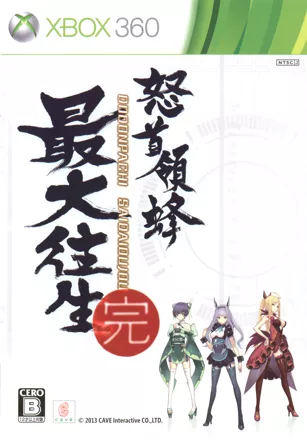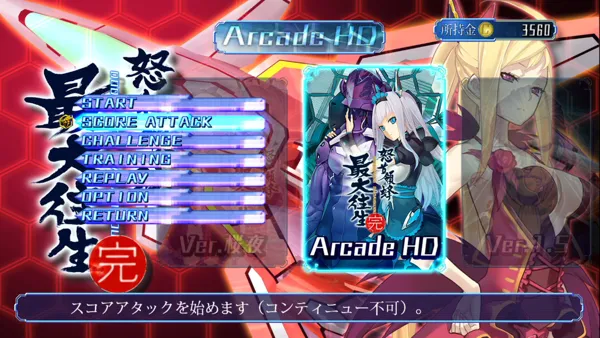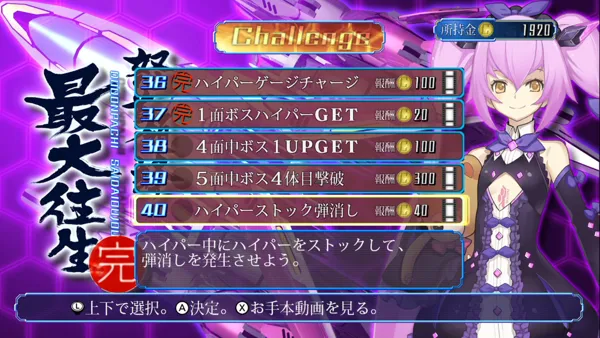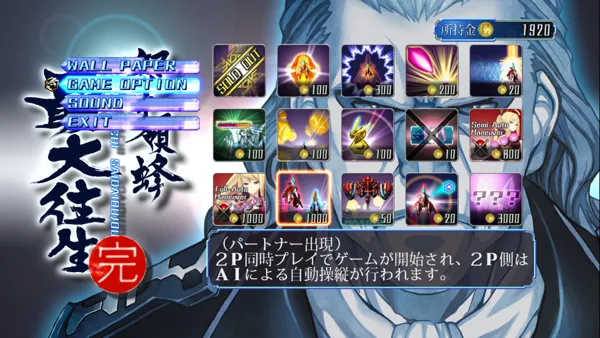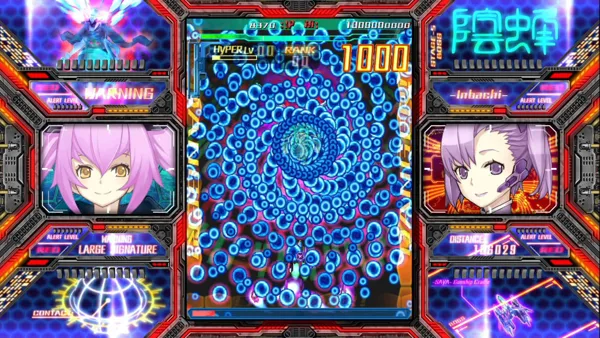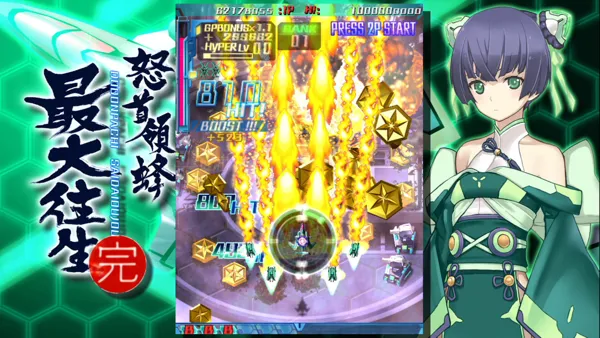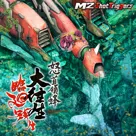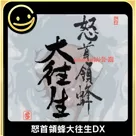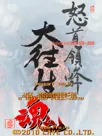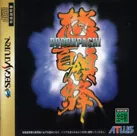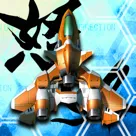DoDonPachi Saidaioujou
Description
Dodonpachi Sai-Dai-Ou-Jou is the final game in the DonPachi series of overhead 2D shooters and Cave's final arcade game. It follows in the footsteps of Dodonpachi Dai-Ou-Jou, featuring a variation on that game's scoring system and a traditional set of Dodonpachi ships. Players choose one of several ships to blast through five intense vertically-scrolling levels, dodging bullets and shooting down countless waves of enemies. Unlike previous Dodonpachi games, there is only a single, tightly-focused loop, and the game's true final boss is encountered at the end of this one loop by collecting every bee medallion in the game, not dying, and not using any bombs.
The plot picks up after the previous two games. Most of humanity was wiped out in the Blissful Death Wars; the survivors group together in cities managed by bio-mechanical element dolls. Hibachi, the element doll of the City of Ideal, is assigned the task of protecting humanity and comes to the conclusion that the best way is to upgrade humans into bio-mechanical creatures like herself. After finishing with the City of Ideal, she sets out for the rest of humanity. The remaining humans respond by scrambling the Dodonpachi squadron to her out; the player controls one of the squadron's ace pilots. The arcade version's story is exclusively told through text in the post-game epilogues but 360 Mode features a more involved, fully-voiced story with animated depictions of element dolls Saya and Operator; the story is unveiled through dialogue between the two characters during and in between levels.
Like in other Dodonpachi games, the player's ship features two kinds of normal attacks: a regular shot, and a laser. The regular shot is a machine gun, providing the player with a rapid, relatively weak shot good at taking out smaller ships. The laser is a focused shot going straight forward, which provides sustained damage good for taking out larger enemies but with slower ship movement. The combo system also works like in previous games. The player has an onscreen combo counter; it goes up by one for every enemy killed with the shot, and goes up for every fraction of a second the player holds a laser shot on a larger enemy. If more than a second goes by without scoring any hits, the combo is dropped and resets back to zero. By carefully sweeping through groups of smaller enemies and staying locked onto larger ones, players can rack up big combos that can last the entire length of a stage. The longer the combo, the more valuable point-scoring items enemies will drop when killed.
Ship selection works similarly to the previous games in the series. The player first chooses one of three ship types (A, B, or C) by selecting an element doll character. Shuri, who pilots Type-A, features a more concentrated shot and fast movement speed; Hikari with Type-B features options that tilt from side to side as the player moves and moderate movement speed; and Maria with Type-C features a spread-out shot and the slowest movement speed. Players can then refine their ship selection via selecting one of three different types of dress for their character, affecting gameplay in the same way that style selection in the previous two games did. The military dress acts like the "shot" style, featuring a powered up regular shot and the most generous bomb allotment; the casual dress acts like the "laser" style, featuring a powered up laser and a moderate bomb allotment; and the swimsuit acts like the "expert" style, featuring both powered up shots and lasers but only a single bomb. In addition, and unlike previous arcade Dodonpachi games, players can choose between enabling or disabling auto-bomb. If a player is hit when this option is enabled and at least one bomb is available, then their entire stock of bombs will be drained instead of losing a life.
Hyper mode returns from Dai-Ou-Jou and Resurrection, sharing elements from both. Hyper powers up the player's normal weapon into a special, ultra-powerful shot or laser for a limited time, letting the player easily clear the screen of enemies and rack up high combos. Hyper can be activated once the player's hyper meter fills to at least one level; meter is earned by collecting point items and killing enemies with a laser. The higher the player's hyper laser when activated, the more power their hyper shot and the longer it lasts. Unlike in Resurrection, there isn't a separate hyper button; instead, like in Dai-Ou-Jou, pressing the bomb button when hyper is available launches a hyper instead of a bomb. As in the previous two games, the player also has a rank, which goes up as the player uses hyper. The higher the rank, the harder the game becomes; the result is that the game is self-balancing, becoming more challenging as the player does more skilled things. Rank goes back down every time the player uses a bomb or dies. Unlike in Dai-Ou-Jou, rank isn't invisible; the number is displayed at the top of the screen, making it easier for players to plan their strategy.
Aside from a direct port of the arcade game, the home port adds a new exclusive 360 Mode. Players take control of new element doll Saya and her ship, Type-Z, which combines elements of all three other ships. Her unique shot features a focused option formation like Shuri's, but her outer two options angle as she banks like a curved version of Hikari's shot. Her ship's speed, meanwhile, falls in between Hikari and Maria. Unique to this mode is a new take on the life bar. Life, bombs, and special attacks are all combined into a single meter; this is displayed on the bottom of the screen as a bar and as a number in the upper right. Part of the meter is used up every time the player uses a bomb or an auto-bomb, and the player gets a game over if they're hit and there isn't enough meter for a bomb. Collecting powerups dropped while hyper mode is active restores the meter, providing a unique way to restore health. In 360 Mode, Saya also has one extra attack: holding both the shot and laser buttons down at once lets her fire both simultaneously for a deadly bullet barrage. This burns energy for as long as the player uses the attack, but in return allows the player to do high-scoring combos that build hyper meter rapidly, thus giving a chance to earn their life back.
The home port also includes several more new features that are standard for the genre. A training mode allows players to try out playing from any stage, with the ability to select their number of lives, bombs, and the status of their meters. A challenge mode tests players' ability to perform a number of core tasks in the game, such as taking out bosses without dying or maintaining a combo throughout a level. A new novice difficulty mode provides a challenge targeted at intermediate players. A new "1.5" mode provides a rebalanced version of the original arcade mode, based on feedback from expert players. A shop mode allows players to purchase unlocks using points earned from playing the other mode; these include concept art, in-game wallpapers, and the ability to play as Saya in arcade mode.
Spellings
- 怒首領蜂最大往生 - Japanese spelling
Groups +
Promos
Videos
See any errors or missing info for this game?
You can submit a correction, contribute trivia, add to a game group, add a related site or alternate title.
Credits (Arcade version)
32 People (27 developers, 5 thanks) · View all
| Director | |
| Support Director | |
| Programmers |
|
| Character Design |
|
| Chief Designer | |
| Designers | |
| Voice Actor : Shuri (Type-A) |
|
| Voice Actor : Hikari (Type-B) | |
| Voice Actor : Maria (Type-C) | |
| Voice Actor : Operator | |
| Voice Actor : Hibachi |
|
| Voice Actors Management : Casting Manager |
|
| Voice Actors Management : Voice Engineer |
|
| Music Composer |
|
| Sound Manager |
|
| Sound Effect | |
| Web Designer | |
| Debug Staff |
|
| Special Assistant | |
| [ full credits ] | |
Reviews
Critics
Average score: 80% (based on 3 ratings)
Analytics
Related Sites +
-
Dodonpachi Saidaioujou X360 Developer Interviews
Interview with the main staff responsible for Dodonpachi Saidaioujou, including both the arcade and X360 teams.
Identifiers +
Contribute
Are you familiar with this game? Help document and preserve this entry in video game history! If your contribution is approved, you will earn points and be credited as a contributor.
Contributors to this Entry
Game added by Ms. Tea.
Additional contributors: Freeman.
Game added October 23, 2018. Last modified March 3, 2025.


